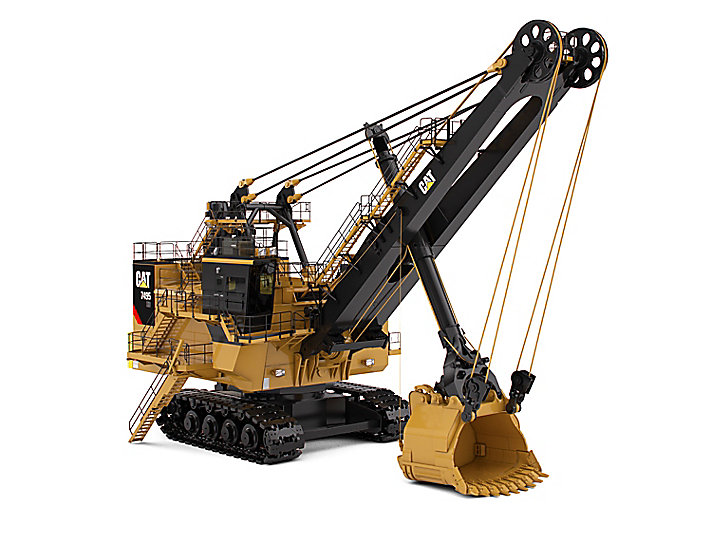Dipper shovel
This is a machine employed for excavating soft rock or loading fragmented rock from a bench and is very commonly used in mines. It is usually mounted on crawler chains. Fig 5.7 B shows the principal parts and controls. The cab carries the power unit which may be an electrical motor at 3300JV, supplied with power from an external source through a flexible electric cable, or a diesel engine. The bucket (also called dipper) commonly used may be of 1 m3 to 4.5 m3 capacity. It is used for loading dumpers and for this purpose it has to stand on the floor of the bench. Watery conditions in the quarry are not suitable for efficient operation of this machine, as dumpers have to move inside the quarry. During operation, the crawlers are stationary within 3 to 5 m of the toe of the bench. To load the bucket, the operator crowds it into the fragmented rock with the dipper stick and hoists it. As it moves through an arc in the rock pile, it gets loaded fig. 5.6 A)- It is then retracted and the cab, along with all the machine mounted on it, the boom and the bucket, is swung horizontally through nearly 90° to position the bucket over the dumper. The bucket is bottom-discharging and its door is opened by the trip cable. Normally five buckets are required to load a dumper. The teeth of the bucket wear out fast and when worn out, have to be built up to size by welding. The trip cable lasts for nearly 35 hours and the hoist cable, for nearly 100 hours. In one shift a shovel loads 450 to 500 buckets. Where the dumping yard is away from the quarry a dipper shovel loading into dumpers is advantageous.

Fig 5.6 A Dipper shovel in operation
Hydraulic shovels which eliminate use of wire ropes (cables) have become popular in recent years. The electric motor or diesel engine mounted on the shovel drives the hydraulic pump and the pressure developed is utilised for various operations of the shovel. Hydraulic motors are of low speed, high torque with hydrostatic braking. One example of such hydraulic excavator is Poclain shovel of Larsen Toubro Ltd.

Fig. 5.7 A. Working ranges of a dipper shovel (maximum). Figures in brackets show the working ranges in m of Tatadipper shovel, model 1055 B, at a boom angle of 50°. Boom length is 8.53 m.
A—Cutting height. (10.83 ) B—Cutting radius. (11.96) C—Dumping radius. ( 9.51)
D—Dumping height. (7.25) E—Cutting depth below crawler level. ( 2.51)
A-8.67 m, A'-5 63 m, B-7.45, B'-7.06 (mm) Hydraulic excavator. Gross power 240 HP.
Dipper shovels commonly employed in Our mines are of 2 m3 - 4.6 m-1 bucket capacities. Only a few mines employ shovels of or 10 m3 capacity, e.g. Matanjkhand Copper Project employs 10 m3 dipper shovels.
Under conditions existing in India the loading capacity of 2 ni3 shovel in good condition and well fragmented rock is as follows:
| Per hour | 80 passes of bucket. |
| Per shift (8-hours) | 500 passes. |
| Per day (2-shifts) | 950 passes or 190 dumper loads or 1070m3 solid. |
| Per week | 5,800 m3 |
| Per month, dry | 23,000 m3 |
| Per year | 2,53,000 m3 |
Loading capacities or performance of other shovels may be considered as follows:
3.5 m3 capacity 400,000 m3 per year
4.5 m3 550,000 m3 per year.
Main specifications of some shovels of B.E.M.L.
Pull shovel (Backhoe) PC 220-3
|
Loading shovel PC 650-3 (diesel)
|
Dipper shovel 182 M-HR-17 (Elec.)
| |
Bucket capacity SAE-Heaped, m3
|
1.0
|
3.8
|
10
|
Operating Weighing
|
22,000
|
67,000
|
3,27,500
|
Flywheel
| |||
Horsepower (H.P.)
|
148 at 2,100 RPM
|
404 at 1,800 RPM
|
600
|
Boom Length,mm
|
5,850
|
8,400
|
12,240
|
Arm Length, mm
|
3,045
|
3580
|
8230
|
Max. Travel Speed km/hr
|
3.4
|
4.1
|
1.61
|
Operating Data Max. digging/ cutting height, m
|
9.18
|
10.68
|
12.70
|
Max. dumping height, m
|
6.36
|
7.71
|
7.65
|
Max. digging depth, m
|
6.70
|
3.43
|
-
|
Max. digging reach, m
|
10.18
|
10.00
|
17.42
|
Overall length, mm
|
10,000
|
9540
|
N.A.
|



No comments:
Post a Comment